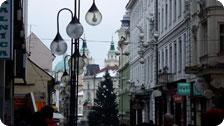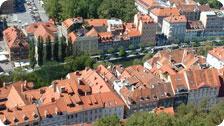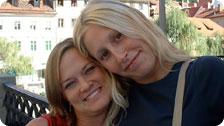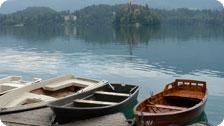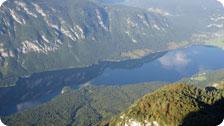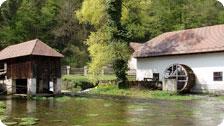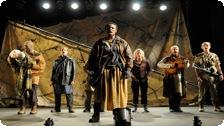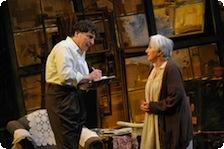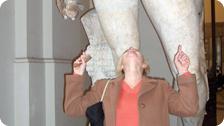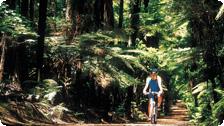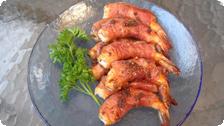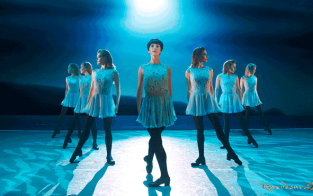Culture: Ljubljana, Slovenia: Slovenian Rhapsody
by Kristin Pedroja
I’ve lived in Ljubljana for nearly two years, and I often find myself singing the praises of the nearby Croatian coast, or the proximity to Venice and southern Austria. But walking along the river promenade on a warm May evening, the magic of this small city hits me. And perhaps it’s because I’m about to leave.
Ljubljana is charming, nestled around a bend in the Ljubljanica River. With fewer than 250,000 people, the city is among the smallest European capitals. Throughout the centuries, it grew like many eastern European cities, slowly eating the surrounding villages and adding atrocious Socialist architecture beside lovely nineteenth-century villas and buildings. But the city center has kept its medieval characteristics, and it buzzes with life, especially as springtime takes hold.
Winters in Ljubljana are harsh. Winter sunshine is a rarity, and cold, grey days engulf people in cocoons for half the year. This year, it snowed the second week of November through the Thursday before Easter, sometimes a little, sometimes a lot.
Then one spring day comes along and changes everything.
We’ve had a few of them this year, the days that make the city sparkle, that flirt with springtime but keep a chill in the air to remind of what’s past. Much like the country itself – balancing a Socialist past with a mere fifteen years of adjusting to capitalism. Then the rains come, the hills burst into millions of shades of green, and Ljubljana blossoms from a cozy, sleepy town to a bustling, colorful city filled with possibility.
Wandering the city on a sunny Saturday morning, I contemplated what I would miss when I leave this city, what things I might wish for a year from now. I first, almost instinctively, wandered to the marketplace, bordered along the Ljubljanica by local architect Plecnik’s Market Colonnade. Dozens of stalls are set up side-by-side every day but Sunday and sell fresh, organic produce – seasonal, of course, which fills the stalls with surprises, whether they be asparagus, cherries, or strawberries. Filling a basket with goodies, then meandering to the fresh flowers – orchids, roses, Gerber daisies, wildflowers from the Slovene countryside – an inexpensive treat to spruce up a room. Inside the Market Colonnade, specialty shops sell fresh bread, cheese, nuts, and meats – horse the delicacy of this country. Below, at water level, a fresh fish market showcases the fruits of the Adriatic and other European waterways.
Crossing Plecnik’s Three Bridges, the architect’s nod to a Venetian bridge, cafes and restaurants spill onto the cobblestones. The tree-lined embankment is the place to see and be seen on sunny afternoons. People-watching is the prime pastime while sipping a cappuccino or a beer. An art market lines the riverbank on Saturdays, and an antiques market on Sundays, adding meandering shoppers to the mix.
Tucked in between the lively cafes are charming shops selling everything from homemade jewelry and accessories to Furla handbags and D&G jeans. In towns like Ljubljana, where space is a premium, the shops are tiny, eclectic, and choosy with merchandise – it’s easy to find one-of-a-kind gems.
Parallel to the embankment are Stari and Mestni Trg, winding around to Gornji Trg, the medieval quarter leading up to the castle. These hilly, cobbled streets boast a jumble of architectural styles cozied up together along the road. Tiny alleyways shoot from the main road, nearly hiding tiny bars and shops. It’s easy to feel like a princess meandering this part of the town, with stories and legends whispering from the windows. Above looms the fortress-like castle, crowning a hilltop.
Perhaps the best part about Ljubljana’s pleasant city centre is how manageable it is. After a day of exploring, it will seem familiar, and it’s easy to choose a favorite spot for coffee, or lunch, or gelato. Preseren Square, named for Slovenia’s national poet, is the oft-photographed heart of the center, the pink Franciscan church dominating the angular space. For most of the year, a cafe sprawls its tables from the street to the embankment, and hosts live music every night of the week. A seat at the café boasts a view from the market all along the embankment, and a stunning view of the castle. Watching dusk fall and Ljubljana light up is something special.
Slovenia proclaims itself ‘Europe in miniature’ and indeed it is; the Julien Alps crawl in the northwestern regions, lush hills and vineyards stretch the length of the country, and its tiny but pretty coastline boasts the warmest temperatures year-round. To drive across Slovenia takes about five hours; from north to south, it’s about three.
Slovenes are very house-proud; even in late autumn and early spring, flowers spill from window boxes and country homes look immaculate. A drive in the Slovene countryside is a joy, watching layers of hills in the distance and seeing adorable small villages that haven’t changed in centuries. Stumbling upon a stall selling fresh honey, cheese, or jams is common. Countryside gostilnas serve massive plates of grilled meats and vegetables, and everywhere in the country is plentiful slivovice (plum brandy) and homemade wine.
It will be sad saying goodbye to Ljubljana, and to Slovenia. Ljubljana’s small size can be stifling, and it does take awhile to find friends in such a small environment – most in my circle are expats – but the lively river promenade and numerous bars keeps things spiced-up.
As a country just 15 years old, Slovenia’s still finding its feet and identity. With barely 2 million people, the country continues to struggle with its socialist Yugoslav past, but remains firmly staring to the West. Capitalism has taken over – from McDonalds to Zara to hot dog stands – but the ideals of the past remain: start early, finish early, savor your free time. Slovenes work to live, and rarely will ‘shop talk’ occur outside of working hours. Perhaps that will be the most important thing I take away: the importance of relaxation, of recharging after a day in the office.
It’s an exciting time for Ljubljana – two cheap airlines already fly into the capital, and it’s becoming a weekend break destination for Europeans. As more hotels open and more airlines begin putting routes on the map, this small city won’t seem so small anymore. It’s worth a few days to see it before it is overrun with drunken fools sloshing about. Savor what Europe might have been like before tourism took over. It’s all part of Ljubljana’s charm – accepting the past, enjoying the present, excited about the future.
Discover more from Tango Diva
Subscribe to get the latest posts sent to your email.
